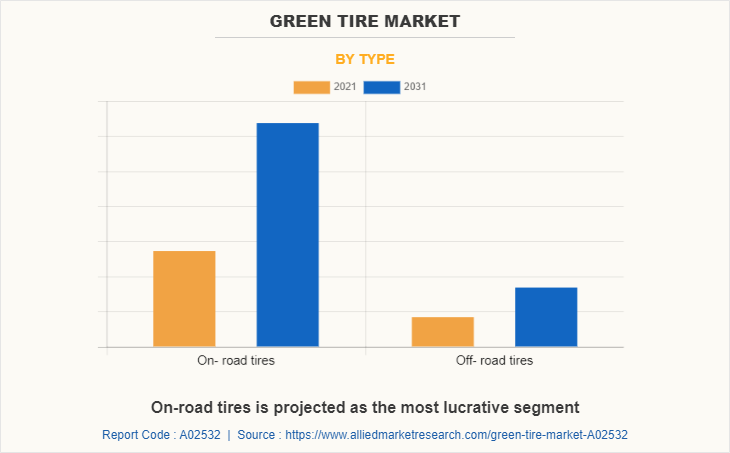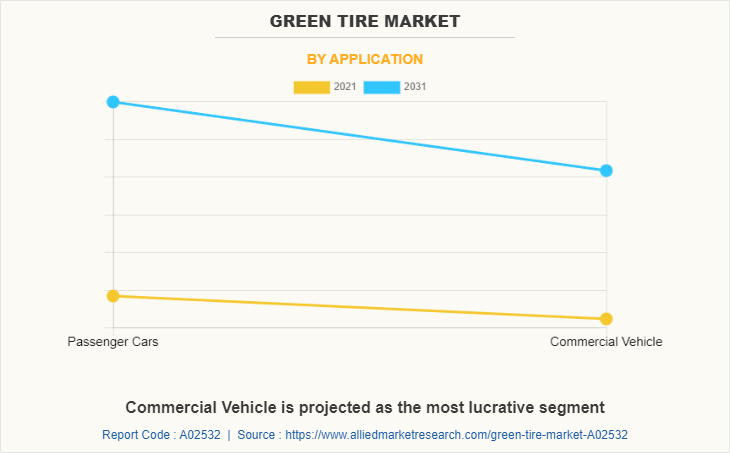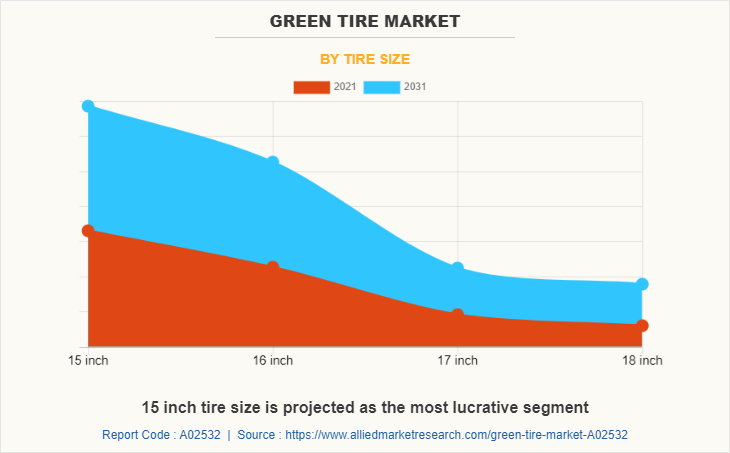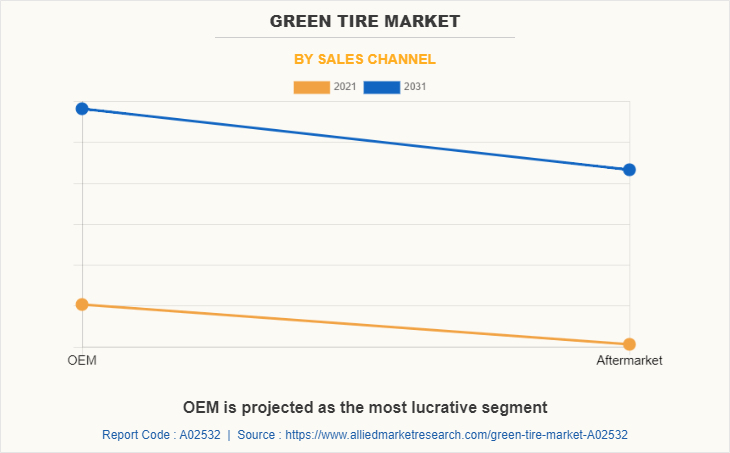The global green tire market size was valued at $35.4 billion in 2021, and is projected to reach $80.6 billion by 2031, growing at a CAGR of 8.7% from 2022 to 2031.
Green tires are produced from renewable materials such as nylon rubber through a process that does not require an excessive amount of energy. These tires have low rolling resistance, which helps in decreasing fuel consumption. The major factors responsible for the growth of the market are increase in sales of commercial vehicles and passenger cars, as well as the demand for environment friendly and fuel-efficient tires. The manufacturing process and materials utilized in developing traditional tires cause high levels of pollution and are sourced from unsustainable resources. Some of these materials include rubber and petroleum-based substances that are added to traditional tires. With crude oil prices always in a constant state of flux, this makes material costs inconsistent, which increases the price. Energy conservation helps in improving fuel efficiency. Rolling resistance consists 10-15% of fuel consumption in passenger cars but can account for up to 30% of fuel consumption in heavy trucks. Low rolling resistance tires may only cut this by 2 to 3%, fuel savings still support the environment.

Green tires are manufactured in additional energy efficient ways and are planned for lower rolling resistance, which leads to lower fuel consumption over the life of the tire. Green tire also uses highly dispersible silica, developed carbon blacks or nanotechnology to attain the smallest possible rolling resistance. Silica helps in the reduction of rolling resistance or the energy lost as the tire deforms against the road. In addition, green tires are made from more sustainable and recycled materials. Carbon dioxide emission levels are directly affected by vehicles fuel consumption. Fuel consumption can be improved by the production of streamlined low rolling resistance tires. These tires cause less friction between the tire and the road allowing the vehicle to use less energy (fuel) to propel the vehicle forward). Modifications in the key design of tires have taken years of research and development. Many leading manufacturers have implemented these changes to their green tires.

The factors such as government regulation & economic drivers, increase fuel efficiency, and reducing rolling resistance supplement the growth of the green tire market. However, lack of awareness about green tire and structural limitation is projected to impede future adoption.. In addition, adoption of eco-friendly tire across the automotive industry and technological advancements in automotive sector create market opportunities for the key players operating in the green tire market
The green tire market is segmented into type, application, end-user, and region. By type, the market is divided into on-road tires and off-road tires. By application, it is fragmented into passenger car and commercial vehicles. By size, it is categorized into 15 inch, 16 inch, 17 inch, and 18 inches. By sales channel, it is classified into OEM and aftermarket. By region, it is analyzed across North America, Europe, Asia-Pacific, and LAMEA.
The leading players operating in the green tire market are MICHELIN, Continental AG, Bridgestone Corporation, Pirelli & C. S.p.A, The Goodyear Tire & Rubber Company, Hankook Tire & Technology, The Yokohama Rubber Co. Ltd., Petlas, Kumho Tire, and MRF.

Green tires are made from more sustainable and recycled materials
The adoption of green tires is largely due to the rise in pressure on vehicle makers to reduce vehicle emissions and meet rise in fuel-economy targets. This pressure is driving the demand for green tires and growing market penetration. Growth of alternative powertrains (hybrid and electric), as well as the evolution to shared/fleet vehicle use, and autonomous vehicles adding additional impetus to green tire adoption and continued gains in rolling resistance reduction are demanded. The replacement market for green tires has also grown through better consumer education and awareness provided by the European Union’s consumer tire labelling plan that rates tire rolling resistance and other performance variables. For instance, the Tire Labelling Regulation provides consumers across Europe with essential information on fuel efficiency, safety, and noise by detailing the tires’ rolling resistance, wet grip, and external rolling noise. This labelling system provides consumers with transparent and objective information about the quality of the tires they buy. Regulatory and labelling plans promoting green tires and replacement of tires, further help in driving the growth of the green tire market.

Increase in fuel efficiency
With the increased price of fuels used in vehicles, the demand for low rolling resistance technology to be used in vehicles has increased. This has created an increased demand for technology efficient tire to be used among vehicles which has supplemented the growth of the green tire market across the globe. Moreover, vehicle & fleet owners can be benefited from innovations in the automotive & supplier industries in making vehicles more fuel-efficient through low rolling resistance tires. Changing to quality tires with low rolling resistance, also called green tires, can effectively and, above all, easily reduce fuel consumption. This is because around 20-30% of a passenger car’s total fuel utilization is caused by the tires rolling resistance alone. For heavy good vehicles it is as much as 40 per cent. Green tires have a considerably lower rolling resistance than conventional tires. Utility vehicles can make fuel savings of up to 10 per cent by employing green tires. Thus, these factors are projected to further drive the growth of the green tire market.

Structural limitation may impede future adoption
Green tires are considered as a revolutionary development in the automotive industry, but there are certain structural limitations which may hinder the market. Due to the presence of less rubber, these tires may have lesser grip, which affect braking, especially on wet roads. This may increase chances of skidding and eventually fatalities due to accidents. A good tread pattern is a vital feature of lessen rolling resistance. If the vehicle/fleet owner want fast tires to be used in the vehicle fleet, there are fewer treads inscribed in the tires as compared to other type of tires. Compromising on the best tread design offers more swift driving, and offers less grip while driving the vehicle. Thus, to the vehicle driver needs to carefully maintain the balance between the tread pattern while selecting a tire. Furthermore, as technologies keep evolving, manufacturers have to continuously upgrade their product offerings, which often increases operational costs, rendering small and medium sized enterprises unable to afford them, limiting sales outreach.

Adoption of eco-friendly tire industry
With the adoption of the Paris Agreement in 2016, the international community jointly agreed to reduce greenhouse gas emissions to limit global warming. Through this accord, the world is accelerating toward a carbon-neutral society and economy, and a new international economic order is on its way. This global decarbonization movement is expected to be driven not because of market demand, but through enforcement of government laws or regulations led by developed countries such as those in the European Union and North America.
However, the automotive industry is already under pressure to become carbon neutral, and as a result component suppliers are developing technologies to reduce their environmental impact. The tire industry in particular is driving the establishment of sustainability strategies based on environmental, social and governance (ESG) management. The companies will release their current situation and drive implementation plans to further stimulate demand in the green tire market. For instance, Hankook Tire will develop and secure technology that will make 55% of its materials sustainable by 2025 and 100% of its materials by 2045, reducing its carbon footprint and making it more sustainable. It announced that it is striving for a future with mobility options.
Key Benefits For Stakeholders
- This report provides a quantitative analysis of the market segments, current trends, estimations, and dynamics of the green tire market analysis from 2021 to 2031 to identify the prevailing green tire market opportunities.
- The market research is offered along with information related to key drivers, restraints, and opportunities.
- Porter's five forces analysis highlights the potency of buyers and suppliers to enable stakeholders make profit-oriented business decisions and strengthen their supplier-buyer network.
- In-depth analysis of the green tire market segmentation assists to determine the prevailing market opportunities.
- Major countries in each region are mapped according to their revenue contribution to the global market.
- Market player positioning facilitates benchmarking and provides a clear understanding of the present position of the market players.
- The report includes the analysis of the regional as well as global green tire market trends, key players, market segments, application areas, and market growth strategies.
Green Tire Market Report Highlights
| Aspects | Details |
| Market Size By 2031 | USD 80.6 billion |
| Growth Rate | CAGR of 8.7% |
| Forecast period | 2021 - 2031 |
| Report Pages | 433 |
| By Type |
|
| By Application |
|
| By Tire Size |
|
| By Sales Channel |
|
| By Region |
|
| Key Market Players | PETLAS, MRF, THE GOODYEAR TIRE & RUBBER COMPANY, BRIDGESTONE CORPORATION, Pirelli & C. S.p.A, KUMHO TIRE, MICHELIN, THE YOKOHAMA RUBBER CO., LTD., HANKOOK TIRE & TECHNOLOGY, Continental AG |
Analyst Review
The green tire market is expected to witness significant growth, due to rise in production and sales of automobiles across the globe. Considerable development in the sales of automotive globally has escalated the danger of carbon emissions and global warming. Tires are one of the world’s most common products for the automotive sector. These products have caused high levels of pollution. Not only the tires themselves, but the manufacturing processes have sent high levels of pollutants into the environment. This creates a possible threat for society, which is regarded as one of the key factors propelling the demand for green tire accelerating toward a carbon-neutral society. It is primarily designed to safeguard against future of the world’s environment and Industries of all types are searching for cleaner forms of energy and production solutions that have less impact on the environment. For instance, in January 2022, Michelin and Hyundai Motor signed a memorandum of understanding (MoU) to develop next-generation tires optimized for premium electric vehicles (EVs). Both companies will jointly develop eco-friendly tires with increased use of eco-friendly materials.
Green tire manufacturers are looking to drastically change the way people look at tires and also increase awareness about green tires. Researching and implementing cleaner working on development of more environment-friendly manufacturing process, as well as using more sustainable raw materials to produce the tires. The goal of these manufacturers to develop all tires greener along with cleaner production processes across the board. Therefore, governments of various countries are coming up with various stringent regulations for vehicles. As a result, tire manufacturers adopt environment-friendly raw materials without compromising on lighter tires, which considerably decreases vehicle weight, providing higher fuel efficiency and less consumption. All advantages of green tires is projected to propel the demand for green tires in the market. For instance, in June 2022, The Bureau of Energy Efficiency, India launched the star labeling program for tires, identical to the rating for electrical appliances. The rating of the tire gives details about rolling resistance and fuel economy.
Apart from this, several advancements in tires for various applications such as Improvements in raw materials have been responsible for advances in rolling resistance and sustainability. For instance, green tires are continually being optimized to achieve the lowest possible rolling resistance by means of fillers such as highly dispersible silica, improved carbon blacks or nanotechnology. Other materials are supporting, some also from the standpoint of reducing rolling resistance, but also from that of general sustainability. Improvements in synthetic rubber attributes and sustainability such as non-petroleum alternatives and the expanded use and supply of natural rubber are major areas of innovation and attention. Initially, the emerging green technologies will be small in volume and value, with greater commercial potential occurring during the forecast period.
The global green tire market was valued at $35.36 billion in 2021, and is projected to reach $80.64 billion by 2031, registering a CAGR of 8.7% from 2022 to 2031
The leading players operating in the green tire market are MICHELIN, Continental AG, Bridgestone Corporation, Pirelli & C. S.p.A, The Goodyear Tire & Rubber Company, Hankook Tire & Technology, The Yokohama Rubber Co. Ltd., Petlas, Kumho Tire, and MRF.
Asia-Pacific is the largest regional market for Green Tire
On-road tire is the leading application of Green Tire Market
Introduction of low resistance rolling tires are the upcoming trends of Green Tire Market in the world
Loading Table Of Content...



